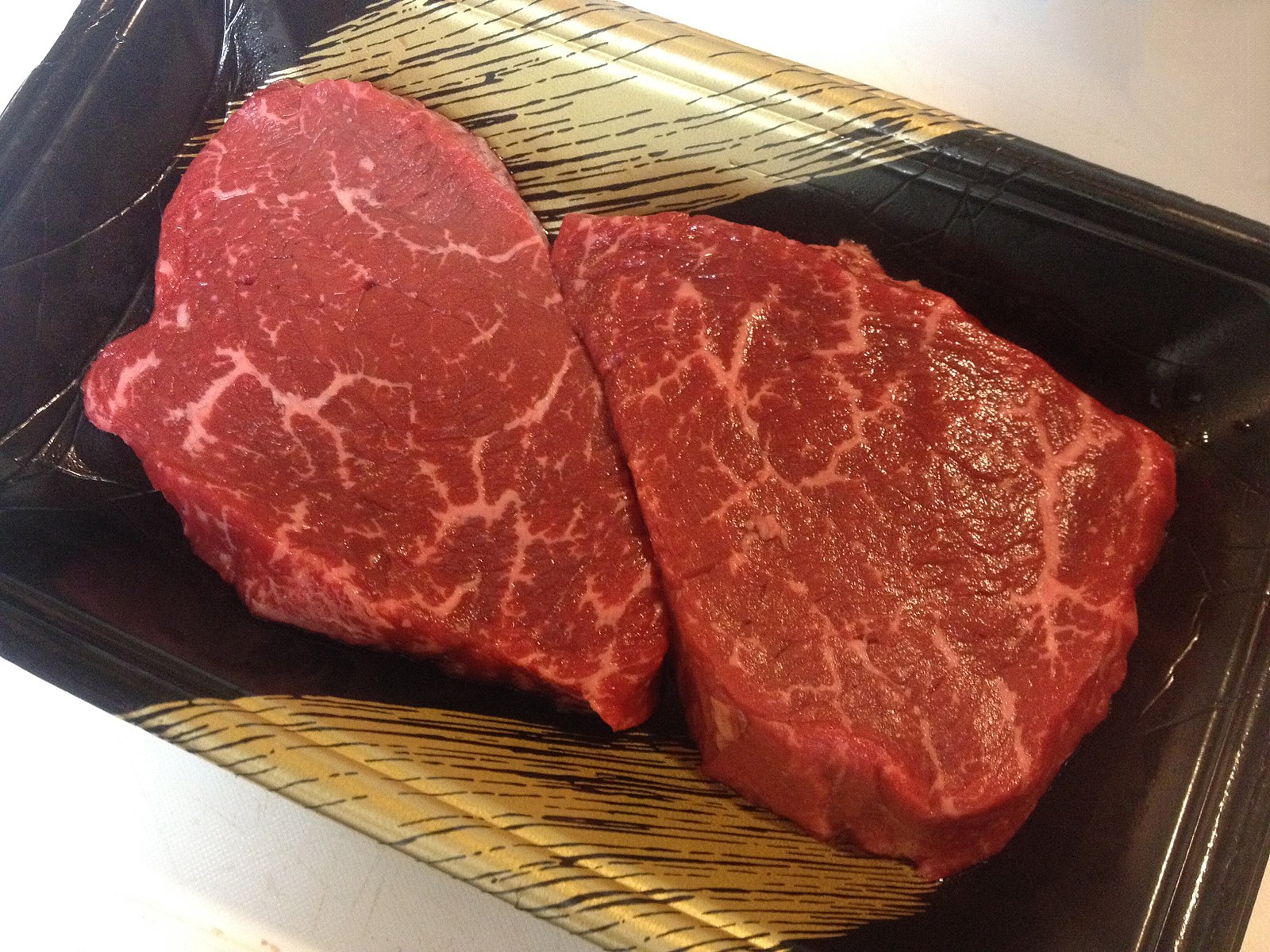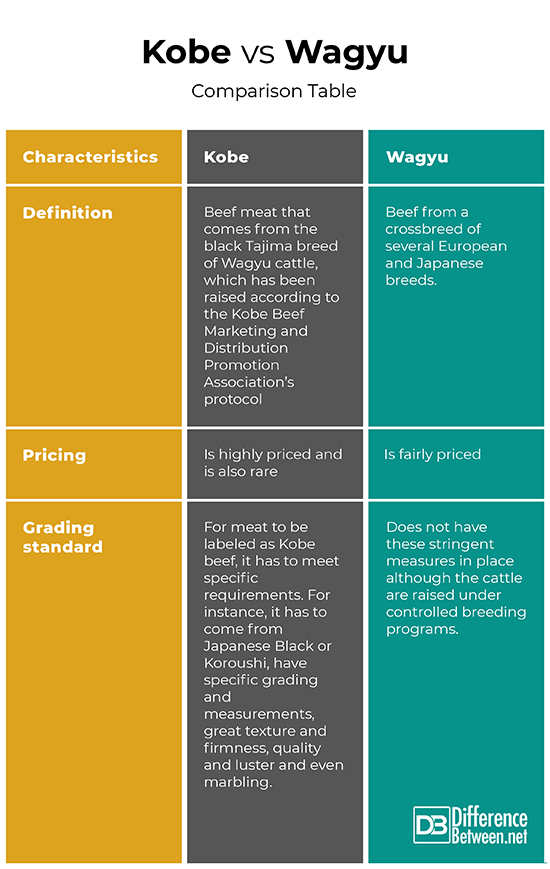Difference Between Kobe and Wagyu
For meat lovers, the choice of the type of beef to consume does not come easy. With the changes in preference of many items among people, many products have been created in a bid to suit people’s needs. The differences in the products manifest in quantity, quality, origin, and even the cost. Japanese beef, for instance, is one of the most popular beef products in steak restaurants. This is due to its high quality. Some of the most common Japanese beef types include Wagyu and Kobe.
What is Kobe?
This is beef meat that comes from the black Tajima breed of Wagyu cattle, which has been raised according to the Kobe Beef Marketing and Distribution Promotion Association’s protocol. It is prized for its tender texture and also the flavor. This meat is only trademarked in Japan and is not readily available outside the country. It is also highly priced in comparison to other types of meat.
To be labeled as Kobe, the cattle must have below characteristics before slaughter;
- Weigh less than 470 Kg
- Meat quality rating of 4 and higher
- Be a virgin cow
- Marbling rating of more than 6
- Fed on a farm within the Hyogo Prefecture
- Meat should be processed within the set Hyogo Prefecture
What is Wagyu?
This is beef from a crossbreed of several European and Japanese breeds. The four breeds of cattle from the crossbreeding dominate the Japanese beef market to this day. The four varieties include;
- Japanese Brown- This is a lean breed, commonly known for its mild and light taste
- Japanese Black- This is prized due to its intensive marbling
- Japanese Shorthorn- It is rich in glutamic and inosinic acid, and has a savory flavor.
- Japanese Pollen- This is known for a rich meaty taste as well as gamier texture.
Wagyu beef has an unparalleled level of marbling and is also fairly priced. The fat melts at a lower temperature, as opposed to other strains of beef. The fat is also unsaturated, and high in omega 3 and omega 6 fatty acids, hence is healthier.
Similarities between Kobe and Wagyu
- Both are beef types common in that are bred in Japan
Differences between Kobe and Wagyu
Definition
While Kobe is beef meat that comes from the black Tajima breed of Wagyu cattle, which has been raised according to the Kobe Beef Marketing and Distribution Promotion Association’s protocol, Wagyu is beef from a crossbreed of several European and Japanese breeds.
Pricing
Kobe is highly priced and is also rare, especially in countries other than Japan. On the other hand, Wagyu is fairly priced.
Grading standard
For meat to be labeled as Kobe beef, it has to meet specific requirements. For instance, it has to come from Japanese Black or Koroushi, have specific grading and measurements, great texture and firmness, quality and luster and even marbling. On the other hand, Wagyu beef does not have these stringent measures in place although the cattle are raised under controlled breeding programs.
Kobe vs. Wagyu: Comparison Table
Summary of Kobe vs. Wagyu
While Kobe is beef meat that comes from the black Tajima breed of Wagyu cattle, which has been raised according to the Kobe Beef Marketing and Distribution Promotion Association’s protocol, Wagyu is beef from a crossbreed of several European and Japanese breeds namely; Japanese Brown, Japanese Black, Japanese Shorthorn and Japanese Pollen.
- Difference Between Profit Center and Investment Center - July 2, 2022
- Difference Between Anti-Trust and Anti-Competition - June 6, 2022
- Difference Between Stocktaking and Stock Control - June 6, 2022
Search DifferenceBetween.net :
Leave a Response
References :
[0]Image credit: https://commons.wikimedia.org/wiki/File:Wagyu_steaks_raw_Japan_-_October_20_2017.jpg
[1]Image credit: https://pixabay.com/photos/meat-beef-kobe-beef-raw-vegetables-361270/
[2]Orange Coast Magazine. Emmis Communications Publishers, 2008. https://books.google.co.ke/books?id=2fsDAAAAMBAJ&pg=PA122&dq=Japanese+kobe+and+wagyu+beef&hl=en&sa=X&ved=0ahUKEwj-tbGN6ffgAhUDSRUIHfCoBxMQ6AEIPzAF#v=onepage&q=Japanese%20kobe%20and%20wagyu%20beef&f=false
[3]CJ Lim. Food City. Routledge Publishers, 2014. https://books.google.co.ke/books?id=rxdgAwAAQBAJ&pg=PA37&dq=Japanese+kobe+and+wagyu+beef&hl=en&sa=X&ved=0ahUKEwj-tbGN6ffgAhUDSRUIHfCoBxMQ6AEITjAI#v=onepage&q=Japanese%20kobe%20and%20wagyu%20beef&f=false
[4]Kummer Corby & Madison Books. 1001 Foods To Die For. Andrews McMeel Publishing, 2007. https://books.google.co.ke/books?id=ptZgNoobsyUC&pg=PA463&dq=Japanese+kobe+and+wagyu+beef&hl=en&sa=X&ved=0ahUKEwiK4vmc6ffgAhVRSxUIHc_QB2I4ChDoAQgzMAI#v=onepage&q=Japanese%20kobe%20and%20wagyu%20beef&f=false



